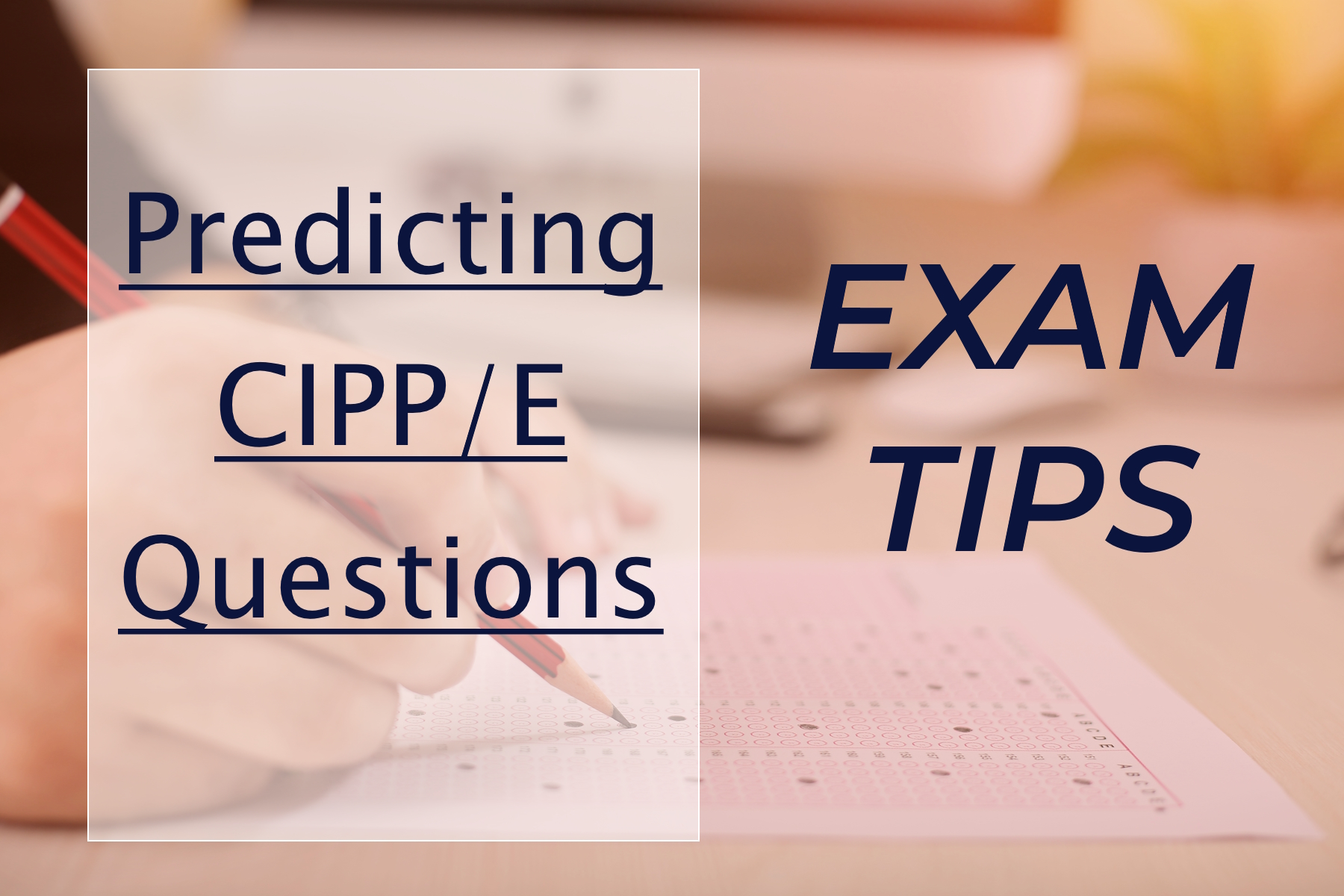Predicting CIPP/E Exam Questions
If you're preparing for the CIPP/E exam, you're probably aware that it consists of 90 questions, all of which are multiple-choice with four answer possibilities. However, don't underestimate the exam, as the International Association of Privacy Professionals (IAPP) has made it challenging by having answers that look very similar, making it hard to identify the right one. While most sample questions available online may seem easy, the questions on the certification exam are much more difficult, making it challenging to prepare for.
Around 15 to 20 of the questions in the exam are based on scenarios. These scenarios have long texts with real-world examples and cases. In this article, I'll explain the different types of multiple-choice questions you'll see on the exam and give you tips on how to approach scenario questions to save time.
Knowing what to expect during the exam makes it easier to study and practice. You can predict the types of questions that will be on the exam and even make your own questions. If you know what to expect, you'll automatically think of the kinds of questions that could be asked when you read an article. That way, you won't be surprised during the exam.
Understanding the Different Structures of Multiple-Choice Questions in the CIPP/E exam
There are eight different structures for multiple-choice questions, seven of which are used in the CIPP/E certification exam (we are disregarding the ‘True or False’ and ‘Yes or No’ types of questions). Here are some generic examples of the ways of asking and answering questions that will help you prepare for the types of questions you will get during the exam.
1. Statement with More Than Two Options
The statement can have more than two options, such as a color, a time period, a number, etc.
Example: What color is the sky?
a. Newspaper
b. Blue
c. Wednesday
d. Green
In this example, it's easy to write off answers A and C, leaving you with B and D, because they are both colors. However, on the certification exam, you might see answer options like this:
a. Greyish blue
b. Blueish grey
c. Red, but only at night
d. The sky has no color, and the blue you normally see is an illusion.
This makes it much harder to choose the right answer since all options look alike. Therefore, you need to study hard to identify the right answer, and there are no half-right answers or points for your efforts.
2. Two Statements with Different True or False Combinations
This type of question consists of two statements, each of which can be true or false, and you have to identify the right combination. Keep in mind that this question format can be lengthy, the statements can be very long sometimes, and they can be introduced by a scenario text.
An example of two statements is:
Statement I: Privacy by Design is a framework for embedding privacy into the design specifications of information technologies, networked infrastructure, and business practices.
Statement II: Privacy by Default means that when a user makes no choice, the strictest privacy settings are applied.
The answer options then typically look like the following:
a. Statement I is true, Statement II is true
b. Statement I is true, Statement II is false
c. Statement I is false, Statement II is true
d. Statement I is false, Statement II is false
If there are more questions in the exam like this, the answer options will always be presented in the same sequence, so it would not be possible to derive your answer from that.
3. Factual questions
Factual questions could be to select the right definition of a certain term. In this case the question is often a short one (“What is Personal Data?”), but the four answers can be lengthy statements or definitions that look very much alike.
TIP: Examples of this can be found in the trial exam. As an extra tip: study article 4 of the GDPR, because you will definitely get questions like this about it.
4. ‘BEST’, ‘NOT’, ‘MOST’, ‘FIRST’, ‘LAST’
This is a tricky question format, where the question will be something like: "Which of the following statements BEST describes the procedure of X?", "Which of the following statements is MOST right?" or “What should company X do FIRST in case of …”, etc.
All answers could be correct, but you have to find the one that is 'most' right or maybe ‘most’ wrong, and it can be hard to distinguish between the nuances. Especially, in questions where you will be asked about the sequence of a procedure, you can imagine that all answers are part of the procedure, but you’ll have to find the first or last one. So, when you see procedures being mentioned in your study material (for example: determining the Lead Supervisory Authority, or Responding to a Data Subject Access Request), make sure you’ll know not only the facts, but also the sequence in which they should take place, or order of importance.
5. Finishing or completing a sentence
They make this format very difficult by often using more than one blank spot in the sentence, which will give you answers that are very much alike: "… is likely if …".
In this format, the answer options can have an overlap, which makes it even harder to find the right answer. The trial exam has a few examples of these types of questions, so you can get used to the format before going up for the certification exam.
6. Situations
In this sixth format a situation or procedure is described in the answer options, rather than in the question, and you will have to figure out which of those is right (or wrong). This means that the answers can be long and complex texts and you should read them carefully.
The questions are typically phrased like this: “In which of the following situations the right procedure has been followed according to X in situation A.”
But beware they could also be asking you about the ‘wrong’ answer, or a negative, which will subconsciously be harder, because most people instinctively are looking for the right answer. So, always carefully read the question.
7. Sequence of Events
In this final format, you will be presented with three events that need to be put in the correct order, often based on their chronological sequence. The answer choices will provide different orders for the events, and you will have to select the correct one.
An example of the answers could be:
a. Event A, event B, event C
b. Event B, event A, event C
c. Event C, event A, event B
d. Event C, event B, event A
These types of questions typically contain three Events, because it is easy to make four answer options. Again, when you have more than one question in the exam according to this format, the sequence of the answers will be the same every time, like in the second format above.
Scenarios
The CIPP/E exam contains four or five scenario and it's good to know that most scenarios, especially the longer ones, have about 3 or 4 questions. So, you will have to find your answer for some twenty questions in long texts with a lot of irrelevant information. If you are not a native English speaker, like me, reading those long texts can take more time that you can spare. You can practice reading in English, obviously, but that will only get you so far.
It's good to know that IAPP uses these scenarios, with different sets of questions, for different versions of the exam, which means that not all the text in a scenario will be relevant. However, you will probably not see any of these questions that can be answered without at least some of the text in the scenario. Also, keep in mind that all of the before mentioned question formats can apply to scenario questions as well.
To save your precious time, it's essential to scan the scenario quickly to get an idea of what it's about and then focus on the questions related to that scenario. Once you have identified the relevant questions, thoroughly read that part of the scenario that pertains to them, and double-check to ensure you haven't missed anything. This approach will help you to save valuable time during the exam and increase your chances of success.
Concluding
To prepare for the certification exam, it's helpful to keep the different question formats in mind while studying the material. Anticipating the types of questions that may be asked can make your preparation much more efficient. The CIPP/E trial exam includes questions in all of these formats, and can be a helpful tool to test your knowledge before taking the actual exam. Because this trial exam doesn’t just give you all of the above question structures, but also has the most accurate distribution of subjects according to the official Exam Blueprint, and the exam environment is most accurate in comparison to the certification exam, it will be your best tool to practice and see if you’re ready.
If you take the trial exam a week before the real exam and don't perform well, you still have time to review and study the material before the actual exam. You can even reschedule your certification exam for free, if you do that at least 48 hours in advance. In any case, make sure you are fully prepared, even before taking the trial exam, because it is difficult. We can help you with your preparation and your study. On 22Academy we offer many training courses for every level.
Good luck with your preparation!



